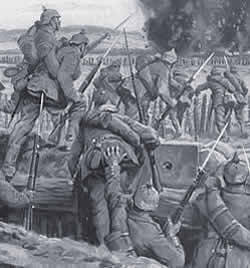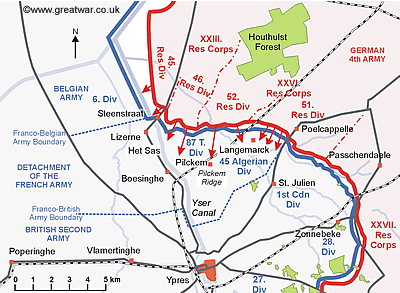 The German infantry advances
The German infantry advances
22 April 1915: 17.15
According to the German Official History, before the greenish-yellow-white cloud of gas even reached the Allied trenches, the enemy infantry could be seen withdrawing after firing off a few shots.

At precisely 5.15pm, following on behind the gas cloud, the German infantry began the attack. They clambered over the parapets of their forward trenches along a front of 9 kilometres. Many were wearing a gauze and cotton mask as protection from the gas.
45. Reserve Division
According to the German Official History the gas on the left wing of the German 45. Reserve Division, under the command of Generalleutnant Schöpflin, did not blow towards Steenstraat with complete success. The German advance was only able to make slow progress as it was up against artillery and infantry fire from the French and Belgian troops defending the line here.
46. Reserve Division
Units of the 46. Reserve Division, commanded by Generalleutnant Hahn, together with some troops of the neighbouring 45. Reserve Division, were able to make an advance towards the Yser Canal and the French held village of Steenstraat.
52. Reserve Division
The effect of the gas was devastating to the French infantry of 87th Territorial Division in front of this German division, commanded by Generalleutnant Waldorf. According to the German Official History the success of the gas had an great effect on the morale of the German soldiers. The storm troop detachments pushed through the French front line positions more or less unhindered here:
“Any resistance was broken by the bayonet.” (1)

The French field artillery in the rear of the French front line (approximately 60 guns located in two main groups to the east of Boesinghe and east of Pilckem) had opened up a bombardment onto the German trenches when the gas was released. During the next 45 minutes the gas seeped further into the rear French positions. As the green cloud dissipated towards the French field gun positions the French gunners could see masses of masked German infantry following behind it. A French artillery officer recalled:
“Despite the gas, the gunners had immediately opened fire with shrapnel until the ammunition was exhausted - and this was quickly done. By lucky chance the chlorine fumes had passed a little north of the batteries. The Germans, their faces covered with some type of mask, had suffered great losses and had stopped for a moment.” (2)
But the fierce German artillery barrage opened up again and soon the 52. Reserve Division soldiers were on the move again behind it, heading in the direction of Pilckem Ridge. Pressing on they captured the French field gun batteries one after the other. In an attempt to rescue the French guns the horses and limbers were sent forward to the field gun batteries but were mostly destroyed before they could pull the guns away to the rear. Many of the French gunners were taken prisoner.
A report on the battle by the Württemberger Kriegerbund (Combattants' Association) wrote about the attack:
“The men of the right wing division [of the XXVI. Reserve Korps], Rheinlanders and Badeners, were opposite white and black Frenchmen, who, panic-stricken, abandoned their trenches and fled. The reserves, who had rushed forward to support the men in the front line, were also caught up and carried back in the rearwards movement of the French infantry.” (3)
Interestingly, this report does not mention the gas emitted 15 minutes before the Württemberger infantry attacked, which was the reason why the French soldiers were reacting with such panic.
51. Reserve Division
The situation to the east of 52. Reserve Division was more difficult. According to the German Official History on the front sector at Langemarck and east of Langemarck the gas had either not been completely effective or the German troops had not followed on immediately with their attack. The 51. Reserve Division troops, commanded by Generalmajor von Kleist, advancing in this sector came up against a stubborn defence from French infantry on the far right of the French line and Canadian troops on the left wing of the British line.
Gas Less Effective Due to Warm Sunshine
With regard to the gas not being so effective in the 51. Reserve Division area, the regimental history of the 238 Reserve-Infanterie-Regiment puts forward a theory. It suggests that by the time the postponed attack took place in the late afternoon the ground had been warmed up by the spring sunshine. The cloud of chlorine did not lie as closely on the ground as it would have done on damp ground in the early hours of the morning. The regimental history confirms that although this did not seem to affect the gas much in their sector, the gas emissions did not function properly for this reason prior to the advance of their neighbouring units to their right and left, namely the 240 Reserve-Infanterie-Regiment and 23 Jaeger Reserve Battalion. (5)
Next>> 13th Canadian Battalion responds to the German attack
Acknowledgements
(1) Der Völkerkrieg, V. Band, p. 161
(2) From Le Drame sur L'Yser by Colonel J J Mordacq, quoted in Gas! The Battle for Ypres, 1915, p. 46
(3) Der Völkerkrieg, V. Band, p. 161
(4) Painting by Alfred Roloff, taken from the German magazine 'Daheim!' (Heft 23) printed in early 1915
(5) Geschichte des Reserve-Infanterie-Regiments Nr. 238, p. 55
Der Weltkrieg 1914 bis 1918: Sommer und Herbst 1915, 8. Band, p. 40